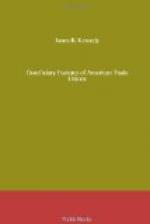| 1895 | 8,600| 2,435.00| .28
| 1896 | 9,600| 1,674.70| .17
|To July 1, | | |
| 1897 | 10,500| 499.00| .10
------------------------------------------------------------
----
In both unions the per capita cost of the benefit was relatively high at the outset, chiefly on account of the larger size of the benefit, but partly on account of the laxity of the rules governing its administration. In the Carpenters the wife’s funeral benefit of twenty-five dollars and fifty dollars to members in good standing for six months and one year, respectively, costs each member about fifteen cents annually. The cost of the seventy-five dollar wife’s funeral benefit in the Tailors’ Union ran in the first year as high as eighty-six and two thirds cents. At the time the benefit was abolished the amount paid was practically the same as that now paid by the Carpenters and the per capita cost had fallen to about seventeen cents in 1896. It may fairly be concluded that a wife’s funeral benefit of twenty-five dollars will cost each member of the union about fifteen cents annually.
The consideration of the cost of the death benefit has been deferred until an examination of the cost of the disability benefit and of the wife’s funeral benefit had been made, since the member’s death benefit, the disability benefit and the wife’s funeral benefit are regarded in the unions with the most highly developed systems as parts of a single benefit. In only a few unions are the payments for these several purposes separated. The unions thus differ so widely in the character of the death benefit paid that it is impossible to institute any comparison as to the relative expense of maintaining the benefit. Some of the systems combine death and disability benefits, some group the death and disability benefits, some pay a wife’s funeral benefit while others do not. It will be possible to describe certain typical systems and to indicate the cost of the benefit in the particular system and certain general differences.
The death benefit of the International Typographical Union may be regarded as the simplest type. The greater number of the death benefit systems found in American trade unions are of this general character. The union pays a benefit on the death of any member in good standing. It pays no wife’s funeral benefit nor any disability benefit. The benefit, when established in 1892, was fixed at sixty dollars, and has since been raised to seventy dollars in 1906. The annual per capita cost of the benefit has never exceeded eighty-four and has averaged less than eighty cents. This extremely low rate has been due to the large number of lapses. The beneficiary system of the union has not been highly developed and members of the union quitting the trade drop their membership. There is no sort of provision whereby members may retain their beneficiary rights on the payment of less than full dues. Only a small part of the dues are devoted to beneficiary purposes. The net result in such systems is that the members of the union get insurance at a low rate at the expense of those leaving the trade.




